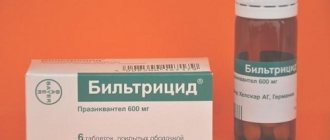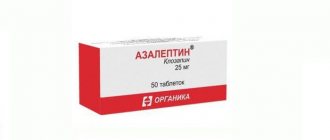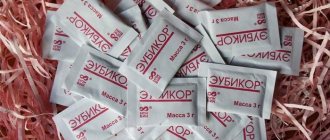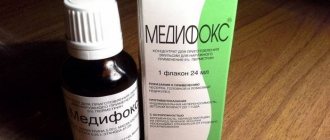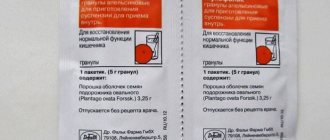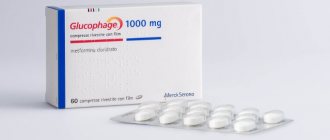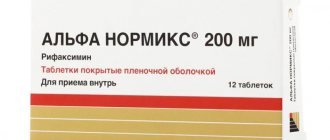In chronic diseases of the bronchopulmonary system, diabetes, and severe metabolic disorders, the acid-base balance is disturbed, which leads to increased symptoms and the development of complications. The drug Cocarboxylase helps restore tissue nutrition; it can be used at any age.
Instructions for use of Cocarboxylase
In Latin, the name of the drug sounds like Cocarboxylase, the medication is produced by domestic and foreign manufacturers, and has been known for a long time. The active component of the drug is cocarboxylase hydrochloride, which has coenzyme properties, eliminates the manifestations of acidosis and returns the human body to normal functioning.
Composition and release form
The drug is known only in the format of a lyophilisate - a powder for the preparation of a parenteral solution. Composition and description:
| Description | Homogeneous, finely porous, hygroscopic mass of white color |
| Compound | One ampoule contains 50 mg of cocarboxylase hydrochloride and 2 ml of solvent - sodium acetate |
| Package | Ampoules with powder 50 mg, pack of 5 ampoules |
Pharmacological properties
Cocarboxylase is a coenzyme (an organic compound that plays an important role in the reactions) of thiamine (vitamin B1). In combination with proteins and magnesium ions, it catalyzes (accelerates) the process of carboxylation and decarboxylation of alpha-keto acids and stimulates the formation of acetyl-coenzyme A. This leads to the normalization of carbohydrate metabolism.
The active substance of the drug is quickly and completely absorbed when administered parenterally. Absorption of the component occurs in the small intestine and duodenum; the substance is excreted after 11 hours. The drug is found in the liver, brain, kidneys, and heart. Red blood cells carry the active component of the drug in the form of thiamine diphosphate. Metabolism of the component occurs in the liver, metabolites are excreted in the urine.
The metabolic effect of the drug occurs due to the activation of tissue metabolism. Cocarboxylase powder is phosphorylated to form phosphorus esters, promotes the rapid absorption of glucose and normalizes the functioning of the cardiovascular system. Also, the active component of the composition improves tissue trophism; with a lack of substance, the level of pyruvic and lactic acids in the blood increases, which leads to the development of acidosis and acidotic coma.
Indications for use
The drug is prescribed for diseases associated with endogenous coenzyme deficiency in combination with B vitamins. Indications are:
- metabolic, diabetic, respiratory acidosis;
- cardiac, renal, respiratory failure;
- post-infarction cardiosclerosis;
- disturbances of carbohydrate metabolism against the background of pathological processes;
- myocardial infarction;
- unstable angina;
- chronic ischemic heart disease;
- hepatic, diabetic coma;
- acute alcohol poisoning, chronic alcoholism;
- multiple sclerosis;
- sepsis, pneumonia;
- diseases accompanied by hypoxia and acidosis;
- infectious diseases.
Composition and release form
Cocarboxylase is a coenzyme, a metabolic substance that improves tissue metabolic processes and their energy supply. The active component is cocarboxylase hydrochloride. Available in powder or lyophilisate form for the preparation of sterile solutions. They are used for injections - intramuscular, intravenous. The medicine can also be administered by drip or placed subcutaneously.
Ampules may contain 0.5 or 0.25 cocarboxylase. The packages with the drug also contain a solvent, which is used to dilute the dry mass. The drug is produced in Russia and Poland.
Directions for use and dosage
The drug can be administered subcutaneously, intramuscularly or intravenously. For adults, 50-100 mg/day is indicated; according to the doctor’s decision, a second dose is administered after two hours. For diabetic coma, the maintenance dosage is 50 milligrams/day. In case of circulatory failure, 50 mg of dissolved substance is administered 2-3 times/day for a course of 2-4 weeks. Patients with diabetes mellitus receive intravenous drips of 100-1000 mg/day for a course of 5-10 days against the background of usual antidiabetic therapy.
For acute liver and kidney failure, Cocarboxylase is administered intravenously at a dosage of 50-150 mg three times a day, or 100-300 mg/day drip in 400 ml of a 5% glucose solution. For peripheral neuritis, 50-100 mg/day intramuscularly for up to 45 days helps. Newborns up to three months receive intramuscular or subcutaneous injections of a solution at a dose of 25 mg/day. Up to seven years, 25-50 mg/day is administered, from 8 to 18 years – 50-100 mg/day.
Possible adverse reactions and contraindications
The use of Cocarboxylase is not allowed if there is hypersensitivity to the active component. When using the drug for the first time, it is advisable to conduct a sensitivity test.
WE RECOMMEND THE ARTICLE!
Enerion is a highly specialized medicine intended for the treatment of asthenic syndrome. Read more >>
There are practically no adverse reactions during treatment with small doses. However, when the medicine is administered intramuscularly at the injection site, hyperemia, swelling, itching and burning may occur. This usually does not require stopping the medication.
An iodine mesh - a pattern of iodine in the injection area - helps reduce swelling and redness.
The likelihood of adverse reactions increases if Cocarboxylase is administered in an amount of 500 mg or more. With this use of the drug, the following symptoms may occur:
- nausea and loss of appetite;
- pain in the epigastrium;
- respiratory failure;
- anxiety, feeling of panic;
- lethargic state;
- ataxia;
- hives, skin rashes;
- contact dermatitis.
When using Cocarboxylase, it is imperative to observe the dosage and frequency of injections. It should be borne in mind that children require a much smaller amount of medicine; for newborns it is calculated based on body weight.
If severe adverse reactions occur, the medicine is discontinued.
An overdose is indicated by symptoms such as:
- increased heart rate;
- heavy sweating;
- headache;
- dyspnea;
- pain in the stomach;
- severe weakness;
- hives.
There is no specific antidote for Cocarboxylase. Therefore, in case of overdose, treatment is selected taking into account all identified changes.
special instructions
Cocarboxylase contains glycocholic acid, which, when administered repeatedly or for a long time to patients with jaundice or cholestasis, can impair liver function. Other special instructions for the drug:
- After diluting the lyophilisate, the solution can be stored for no longer than a day at a temperature of 2-8 degrees, but it is better to use it immediately.
- It is unknown how the drug affects speed and concentration, because the patients receiving treatment were in moderate to severe conditions and were physically unable to drive vehicles and machinery.
- Laparoscopy - what kind of surgical method is it? When to perform diagnostic and surgical laparoscopy
- How to cook chicken gizzards - recipes with photos. Dishes made from chicken gizzards, stewed, boiled or baked
- Histology - what is it: what tissue analysis shows
Reviews
We have selected some reviews from people who have taken the drug Cocarboxylase:
- Maria. I had very severe and debilitating toxicosis, my weight dropped by 6 kg, the doctor considered it necessary to prescribe cocarboxylase. The drug was administered intravenously and the suffering was alleviated after ten injections. Then a healthy baby was born.
- Victor. I was prescribed the drug after suffering a cardiovascular disease. No significant changes were noticed, but the doctor said that positive dynamics were emerging.
- Allah. The drug cocarboxylase is wonderful, it eliminated tinnitus. Received 10 intravenous injections. Thank you. I will take two courses a year. I have low blood pressure.
Cocarboxylase during pregnancy
Indications for the use of the drug during pregnancy include fetal hypoxia and treatment of toxicosis as part of complex therapy. Pregnant women are prescribed a course of medication for 10 days at 50 mg/day. The lyophilisate is dissolved with 20 ml of glucose, injections are given intravenously in combination with a solution of ascorbic acid (vitamin C).
Drug interactions
Cocarboxylase, like most other medications, can enhance or, conversely, reduce the therapeutic activity of other medications. Combining the drug with neutral or alkaline solutions is not recommended. When including cardiac glycosides and B vitamins in the treatment regimen, it is necessary to take into account that Cocarboxylase enhances their therapeutic effectiveness.
The effect of the drug is enhanced by antidepressants. The combination of Cocarboxylase with cyclophosphamide reduces the toxicity of the latter medication.
Analogs
There are several popular substitutes for the drug from different manufacturers, but with the same name. Their description:
- Cocarboxylase Improv is a coenzyme obtained in the body from thiamine;
- Cocarboxylase Ferein is a complete analogue of the drug with the same therapeutic effect;
- Ellara cocarboxylase is a metabolic agent in the form of a lyophilisate;
- Cocarboxylase Hydrochloride is a coenzyme that takes part in carbohydrate metabolism.
Properties and action
Cocarboxylase is endogenously synthesized from vitamin B1 and is a coenzyme. Coenzymes (coenzymes) are components of enzymes - proteins that serve as catalysts for all biochemical reactions. The functions of coenzymes are usually performed by vitamins. Cocarboxylase is a coenzyme of enzymes that regulate saccharide metabolism. In combination with protein and magnesium ions, it is an integral part of the carboxylase enzyme, which serves as a regulator of saccharide metabolism, prevents the accumulation of lactic and pyruvic acids in the body, and stimulates the absorption of glucose. All this contributes to more efficient energy production, which means improved metabolism throughout the body.
Thiamine, entering the body, is first broken down into cocarboxylase, and only in this form does it take part in metabolic processes. Thus, cocarboxylase is the active form of coenzyme obtained from thiamine during its endogenous breakdown. However, the biochemical properties of thiamine pyrophosphate are not identical to the properties of thiamine, therefore cocarboxylase is not used in the treatment of diseases caused by vitamin B1 deficiency. It is used in complex therapy for various pathological conditions that require stabilization of carbohydrate metabolism.
Thiamine pyrophosphate promotes the absorption of glucose, normalizes metabolism in nervous tissue, and restores the functions of the heart muscle. A lack of cocarboxylase leads to an imbalance in the acid-base balance of the blood (acidosis), which leads to severe pathologies of all organs and systems, and can lead to coma and death.
The effectiveness of cocarboxylase has been proven by many clinical studies.
Cocarboxylase price
The cost of the drug is influenced by the level of the seller’s trade margin and the cost of raw materials from different manufacturers. Approximate prices for medication when purchased through online stores and pharmacies in Moscow will be:
| Manufacturer of ampoules 50 mg with solvent | Price for 1 piece. on the Internet, rubles | Cost for 1 piece. at the pharmacy, rubles |
| Moskhimfarmpreparaty | 47 | 50 |
| Microgen, Tomsk | 26 | 29 |
| Virion | 51 | 55 |
| Bryntsalov | 16 | 18 |
| Microgen, Perm | 180 | 190 |
Indications for use and price
The average price of cocarboxylase in ampoules and bottles is 110-115 rubles. You can buy cocarboxylase in pharmacies.
Application of cocarboxylase and indications:
- Diabetic, metabolic, respiratory acidosis
(disturbances in the acid-base state, they manifest themselves as a low blood pH level and a bicarbonate concentration below normal. - Hypoglycemia, hyperglycemia (high and low sugar levels).
- Pathological processes occurring in the body, accompanied by disorders of carbohydrate metabolism. Diseases in this group can be hereditary or acquired. The most common are galactosemia, generalized glycogenosis, and diabetes mellitus.
- Hepatic, respiratory, renal, heart failure. Relevant for acute and chronic forms of diseases.
- Post-infarction cardiosclerosis
- as a component of complex treatment of cardiovascular diseases, in more detail). - Hepatic coma.
- Diabetic coma. (Very often occurs as a result of violations)
- Chronic alcoholism and acute alcohol poisoning.
- Poisoning with barbiturate drugs, digitalis
. - Paratyphoid fever, scarlet fever, diphtheria, typhus - as a component of complex therapy.
- Multiple sclerosis, peripheral neuropathy.
- Perinatal hypoxic encephalopathy, pneumonia, sepsis, respiratory failure in newborns.
- Conditions accompanied by acidosis and hypoxia.
Cocarboxylase how to dilute and inject
With frequent drinking of alcohol, the functioning of all organs and systems occurs. Because of this, metabolic products are not removed in full, and an imbalance in acid-base balance occurs. In order to establish normal tissue nutrition and overcome acidosis, the drug Cocarboxylase is prescribed.
In order to establish normal tissue nutrition and overcome acidosis, Cocarboxylase is prescribed.
Pharmacotherapeutic group
Metabolism improver; refers to vitamin-like substances.
Pharmacological properties
Accelerates the processing of alpha-keto acids. Helps relieve tissue acidification.
Metabolism improver; refers to vitamin-like substances.
Pharmacodynamics
The substance is a coenzyme of thiamine. Part of enzymes that break down acids. Participates in the metabolism of fats and glucose. Improves the absorption of carbohydrates, nutrition of nervous system tissues, and the functioning of the heart and blood vessels.
When taking the drug, the content of pyruvic and lactic acids decreases, which is the prevention of acidotic coma.
Pharmacokinetics
After injection into a vein, the coenzyme is well absorbed. Does not accumulate in tissues. Excreted by the kidneys.
What is different about Cocarboxylase Forte
Available in tablet form. The working substance is thiamine pyrophosphate chlorodiaminoacetate-magnesium(II) potassium salt trihydrate (50 or 25 mg per 1 tablet). There are 30 pieces in a package.
Cocarboxylase Forte is available in tablet form.
Why is Cocarboxylase prescribed?
Indications for use of the drug are as follows:
- blood acidification in diabetes mellitus (with diabetic disorders, pyruvic and lactic acids accumulate in the tissues);
- an increase in the level of CO₂ (carbon monoxide) in the blood, which causes acidosis (this condition occurs with respiratory failure);
- coma and precoma of various origins (diabetic, septic, hepatic; metabolic disorders occur);
- inflammation of the heart muscle, rhythm disturbances and other heart diseases;
- inflammatory diseases of peripheral nerves, mild forms of multiple sclerosis;
- severe form of late gestosis in pregnant women (accompanied by increased blood pressure and accumulation of metabolic products);
- alcohol poisoning, treatment of chronic alcoholism;
- posthypoxic conditions in children and adults, respiratory acidosis.
Treatment often occurs in combination with other drugs.
Directions for use and dosage
Tablets of the drug are used enterally. The solution is injected into the muscle and into the vein. It can be administered intravenously by stream or drip. According to the instructions for use, the dosage is prescribed individually.
For an adult – 50-100 mg on the first day, then a maintenance dose of 50 mg. For a child, the dose can be divided into 2 doses. Children up to 3 months – 25 mg per day. Children from 4 months to 7 years – 25-50 mg per day.
Children 8-18 years old – 50-100 mg.
How to breed Cocarboxylase
The lyophilisate must be dissolved with the supplied solution immediately before use.
How to prick
When administered intramuscularly, an injection can be given immediately after dilution with a solvent. In order to inject into a vein, you need to dilute the prepared solution with saline or 5% glucose to 20 ml.
When administered intramuscularly, an injection can be given immediately after dilution with a solvent.
IV
For drip administration, the prepared solution of the drug is added to a bottle of saline solution or 5% glucose with a volume of 200-500 ml.
Why is it prescribed for pregnant women?
During severe gestosis (preeclampsia, eclampsia), when there is a high threat to the life of the mother, Cocarboxylase is used. Medicine is also prescribed for fetal hypoxia.
During severe gestosis (preeclampsia, eclampsia), when there is a high threat to the life of the mother, Cocarboxylase is used.
In childhood
Approved for use in children from 3 months. The doctor prescribes the drug according to age-specific dosages.
In old age
For older people, the dosage is prescribed individually; The specialist focuses on the general condition of the patient’s body.
For liver dysfunction
The drug is used as part of complex therapy in the treatment of severe damage to liver tissue and liver failure.
For impaired renal function
For acute and chronic renal pathology, the medication is used in combination with other medications.
For acute and chronic renal pathology, the medication is used in combination with other medications.
Carboxylose overdose
Overdose is possible only if large doses of the drug are used (over 500 mg). Manifestations of heart failure and respiratory problems are likely.
There is no specific antidote. Treatment is symptomatic.
Drug interactions of Carboxylase with other drugs
It is better not to combine the drug with alkaline or neutral solutions.
The effect of the drug is enhanced by antidepressants.
Carboxylase enhances the effect of cardiac glycosides and B vitamins.
Alcohol compatibility
The medication is prescribed after alcohol abuse to relieve the effects of alcohol poisoning, so it is better to abstain from drinking alcohol during treatment.
The medication is prescribed after alcohol abuse to relieve the effects of alcohol poisoning.
Carboxylase storage conditions
At room temperature, in the dark. In a place inaccessible to children.
Best before date
From the date of manufacture it is valid for 3 years.
Doctors
Maxim Alexandrov, cardiologist
I prescribe Cocarboxylase to my patients with heart failure. Almost everyone who carefully followed the recommendations noted an improvement in their condition after the 3rd injection.
Valentina Gopeva, cardiologist
The drug helps improve the condition of post-infarction cardiosclerosis. This indicates the effectiveness of the drug.
Patients
Valentina, 50 years old, Vologda
Arrhythmia began to bother me about 5 years ago. Riboxin was prescribed. I didn't feel any effect from it. Then they prescribed Mildronate vitamins.
They did not help cope with the arrhythmia, but made me irritable. At the next appointment, the doctor prescribed the medicine Cocarboxylase. I made a course of 10 injections. I immediately noticed the effect.
The rhythm became less frequent, and if an attack did occur, it was much easier to bear.
Source: https://doctor-grebnev.ru/info/kokarboksilaza-kak-razvodit-i-kolot/
Indications for use
As a vitamin preparation, the use of Cocarboxylase is indicated in combination therapy of the following diseases:
- Acidosis due to hyperglycemic coma, metabolic acidosis, acidosis due to pulmonary-cardiac and respiratory failure;
- Myocardial infarction, coronary heart disease, chronic heart failure, unstable angina, post-infarction cardiosclerosis;
- Kidney failure;
- Poisoning, intoxication with barbiturates or cardiac glycosides;
- Alcoholism in acute or chronic form;
- Liver failure;
- Typhoid fever, scarlet fever, diphtheria, paratyphoid fever and other diseases of infectious origin;
- Multiple sclerosis, neuralgia, peripheral neuritis.
The drug is prescribed to children during the neonatal period for perinatal hypoxic encephalopathy, pneumonia, respiratory failure, hypoxia, sepsis, and acidosis.
